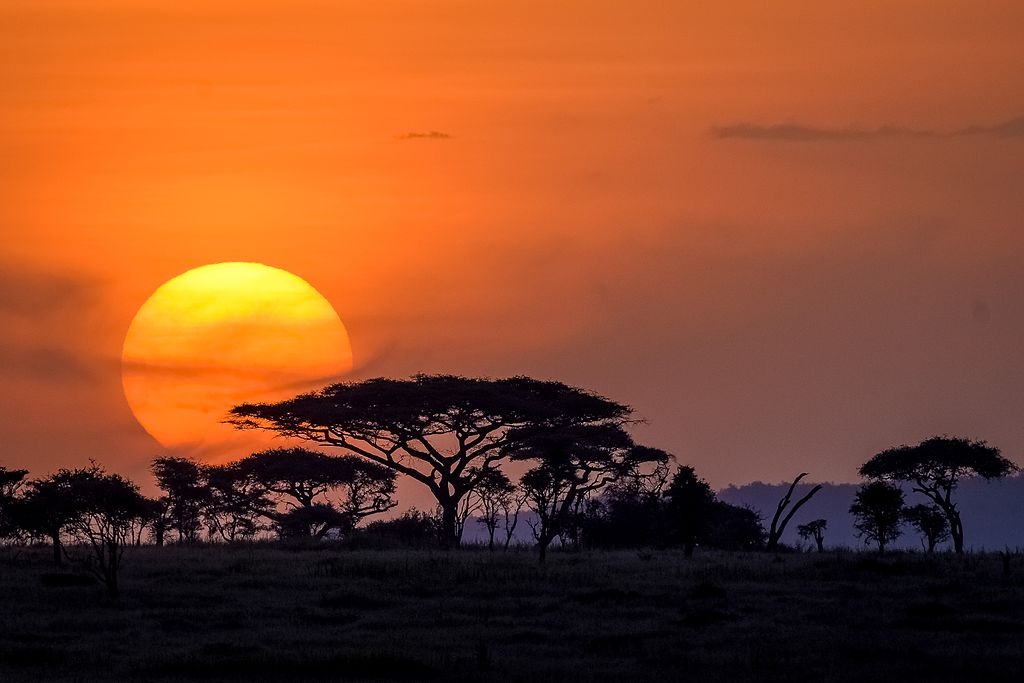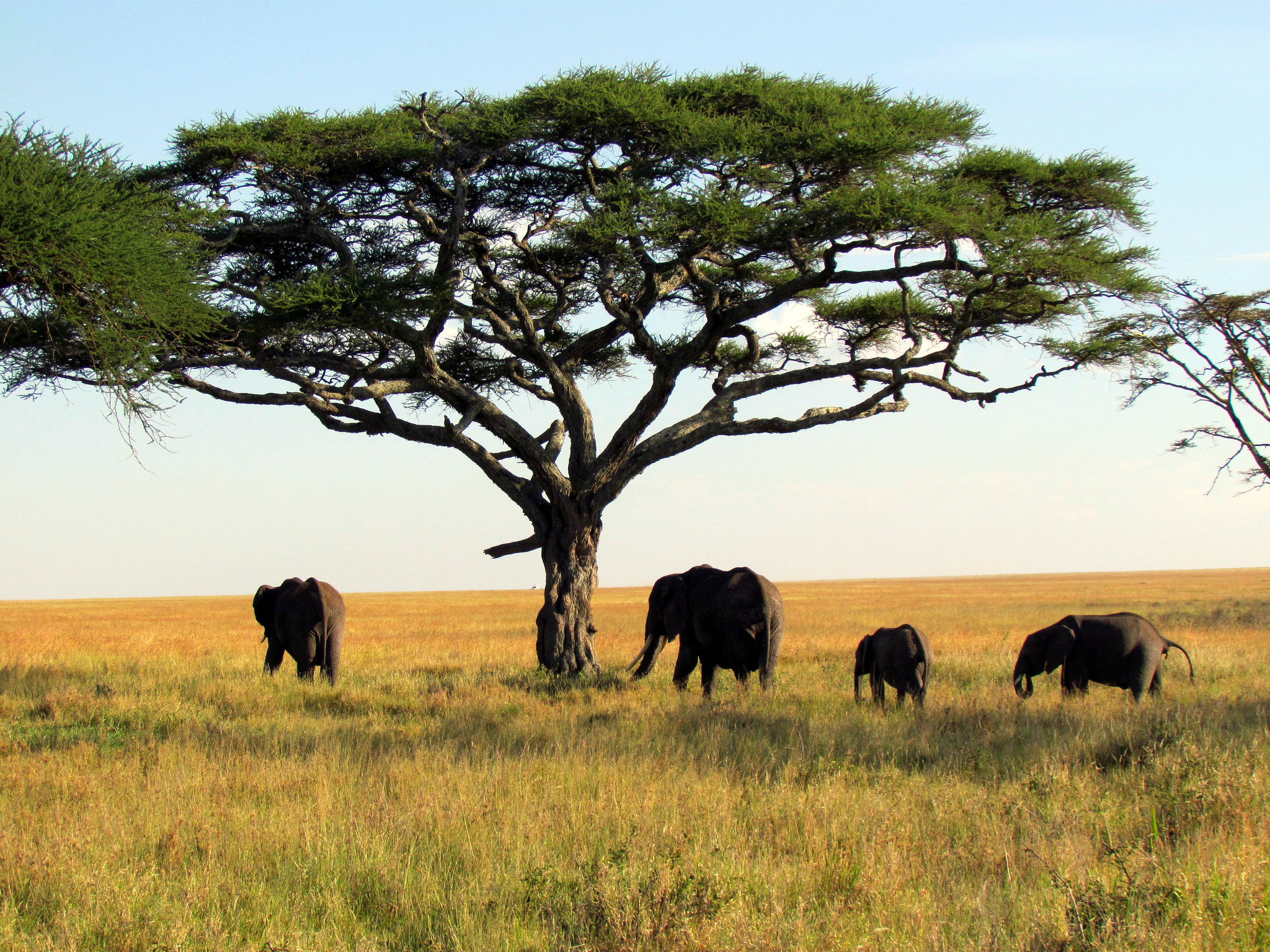●세렝게티 국립공원
Serengeti National Park

그레이트 리프트 밸리 서쪽의 탄자니아에 광대 한 평원. 1951년 세렝게티 국립공원은 이 지역의 많은 누우, 얼룩말 및 톰슨가젤을 보호하기 위해 만들어졌습니다.
Wild a vast plain in Tanzania, west of the Great Rift Valley. In 1951 the Serengeti National Park was created to protect the area's large numbers of wildebeest, zebra, and Thomson's gazelle.
케냐 국경까지 뻗어 있으며 거의 빅토리아 호수까지 이어지는 14,763 평방 킬로미터의 끝없는 회전 평원을 다룹니다. 공원은 웅장한 야생 동물이 번성하고 있습니다. 약 300 만 마리의 큰 동물들이 평원을 돌아다닙니다. 마사이족 사람들은 시링 투투 (Siringitu)라고 불렀습니다. “땅이 영원히 움직이는 곳”세렝게티는 세계 최고의 야생 동물 보호 구역 중 하나로 알려져 있습니다.
이 지역 내에 2 개의 세계 유산과 2 개의 생물권 보전 지역이 설립되었습니다. 독특한 환경으로 인해 작가, 영화 제작자, 수많은 사진가 및 과학자들이 열광했습니다. 세렝게티 생태계는 지구 상에서 가장 오래된 생태계 중 하나이며 기후, 동식물의 주요 특징은 지난 수백만 년 동안 거의 변하지 않았습니다.
세렝게티는 동물의 이동으로 유명합니다. 매년 10 월과 11 월에는 짧은 열대성 비가 내리고 백만 마리 이상의 누우와 약 220,000 마리의 얼룩말이 북쪽 언덕에서 남쪽 평원으로 이동 한 다음 4 월에서 6 월까지는 긴 장마 후 서쪽과 북쪽으로 여행합니다. 이 동물들의 오래된 본능은 너무 강해서 가뭄, 협곡 또는 악어가 득실거리는 강은 그들을 막을 수 없습니다. 누우는 많은 공원, 보호 구역 및 보호 지역과 다양한 서식지를 통해 이동합니다.

covers 14,763 sq km of endless rolling plains, which reach up to the Kenyan border and extends almost to Lake Victoria. The park is flourishing with magnificent wildlife. An estimated 3 million large animals roam the plains. People of the Masai Tribe called it Siringitu – ‘the place where the land moves on forever.’ The Serengeti is known as one of the best wildlife sanctuary in the world.
Two World Heritage Sites and two Biosphere Reservates have been established within this area. It’s unique environment has enthused writers, movie makers as well as numerous photographers and scientists. The Serengeti ecosystem is one of the oldest on earth, the main characteristics of climate, flora and fauna have hardly changed in the past million years.
Serengeti is renown for the migration of animals. Every October and November, more than a million wildebeest and about 220,000 zebras travel south from the northern hills to the southern plains for the short tropical rains, and then journey west and north after the long rains in April to June.
The animals’ ancient instinct to move is so strong that no drought, gorge or crocodile infested river can hold them back. The Wildebeest migrate through a number of parks, reserves and protected areas and through a variety of habitat.
●야생동물●
Wildlife
세렝게티는 패터슨의 고지대, 클립 스프링 어, 딕 디크, 얼룩말, 가젤, 사자, 임팔라, 표범, 치타, 하이에나 및 코뿔소, 기린, 코끼리 및 하마와 같은 다른 큰 포유류를 포함하며 많은 영양의 무리를 자랑합니다. 공원에는 약 500 종의 조류가 기록되어 있습니다.
The Serengeti boasts large herds of antelope including Patterson’s eland, klipspringer, dikdik, Zebra, gazelles, lion, impala, leopard, cheetah, hyena and other larger mammals like the rhino, giraffe, elephant and hippopotamus. Nearly 500 species of birds have been recorded in the park.



●날씨●
Weather
세렝게티의 기후는 따뜻하고 건조합니다. 열대 우기는 3 월에서 5 월이며, 10 월에서 11 월까지는 짧은 비가 내립니다. 비가 내린 후 세렝게티는 무성하고 초록색이지만, 꾸준한 건조는 식물의 성장을 방해하고 동물들이 물을 찾아 이동하도록 합니다. 920에서 1,830 미터 사이의 고도에서 평균 온도는 15도에서 26도까지 다양합니다. 가장 추운 온도는 6 월부터 10 월까지입니다.
The Serengeti’s climate is warm and dry. The tropical rainy season is from March to May, with short rains from October to November. The Serengeti is lush and green after the rains, but a steady drying up follows which inhibits plant growth and encourages the animals to migrate in search of waters.
With altitudes ranging from 920 to 1,830 metres average temperatures vary from 15 degrees to 26 degrees Celsius. The coldest temperatures are experienced from June to October.
●야생의 순환●
Wild cycle
1월
이주는 신선한 잔디를 키우는 짧은 비가 내린 후 짧은 잔디 평원의 남동쪽 세렝게티에 있습니다. 이 달과 12 월은 얼룩말의 출산이 가장 높은 달입니다.
January
The migration is in the southeastern Serengeti on the short-grass plains after the short rains which have nurtured fresh grass. This month and December are the peak months for zebra birth.

2월
짧은 잔디 평원은 약 2 백만 마리의 누우, 얼룩말, 가젤의 주요 먹이 장소입니다. 포식자들은 가까이 다가와서 갓 태어난 새끼를 잡아먹습니다. 이달은 누우 출산의 주요 달입니다.
February
The short-grass plains are the main feeding ground for some two million wildebeest, zebra and gazelle. Predators lurk close by, feeding on the newborn. This is the main month for wildebeest calving.

3월
긴 폭우의 시작. 강한 구름이 남쪽에서 나타나고 때때로 번개가 밤하늘을 비 춥니다. 짧은 잔디 평원의 목초지는 거의 다 고갈됐고 새끼들은 무리를 따라갈 수 있습니다.
March
Beginning of the long and heavy rains. Clouds, growing in intensity, appear from the south and occasional lightning illuminates the night sky. The short-grass plains’ pastures are nearing exhaustion and the newborn can keep up with the herds.

4월
가장 비가 많이 오는 달. 누우는 짧은 평야에 대부분 고르게 흩어져 있습니다.
April
Heaviest rainy month. Wildebeest are almost evenly scattered on the short-grass plains.
5월
먹이는 여전히 있지만 물은 제한적인 요소가 되기 시작합니다. 이제 광대 한 무리는 삼림 지대를 가로질러 서부 회랑으로 그루 메티 주변의 비에 의해 새로운 음식과 물이 생성된 것처럼 수 km에 걸쳐 수십만의 떼가 무리와 합쳐지기 시작합니다.
May
Good forage still available but water begins to be a limited factor. Now the vast herds begin to coalesce with columns containing hundreds of thousands stretched over many km as they had across the woodland zones into the Western Corridor where new food and water has been generated by the rains around Grumeti.

6월
비가 끝나고 무리는 검은 면토 평원을 떠나 그루 메티 강을 건너 매년 많은 누우가 익사하는 곳의 교차점에 숨어있는 악어에게 먹이를 제공합니다. 정상적인 해에는 세로네라 / 모루 코 페스 지역에 있을 것입니다.
June
Rains come to an end and the herds leave the black-cotton-soil plains, crossing the Grumeti River where many wildebeest drown every year providing food for the crocodiles who lurk at crossing points. In a normal year they will be in Seronera/Moru kopjes area.

7월
이제 이주는 그루 메티 통제 구역으로 진입하면서 공원을 떠나 잠깐 북서로 향하고, 소의 일부는 로보 지역으로 향합니다. 아침 기온이 급격히 떨어집니다.
July
The migration now heads northwest briefly leaving the park as they enter the Grumeti Controlled Area, with a small portion of the herd heading towards the Lobo area. morning temperatures have fallen sharply.
8월
이주자와 따라다니는 포식자는 이제 이코 론고 통제 지역을 가로질러 이동합니다. 이주단은 다양한 지점에서 만나기 시작합니다. 일반적인 해의 이주는 이제 세렝게티 북부에서 마사이 마라로 진입해야 합니다. 아침에는 여전히 춥습니다.
August
The migration and the ever-attendant predators trailing now cross the Ikorongo controlled Area. The various branches of the migration begin to meet up. The migration in a normal year should now be in the northern Serengeti and entering Maasai Mara. It is still cold in the mornings.

9월
이주 그룹은 이제 세렝게티에서 북쪽 경계를 건너 케냐의 마사이 마라 야생동물 보호구역에 들어갑니다. 기온이 상승하기 시작하고 하늘은 낮에 파랗습니다.
September
The migration group has now entered Kenya’s Maasai Mara Game Reserve just across the northern border from the Serengeti. Temperatures begin to rise and the skies are blue by day.
10월
세렝게티에서 가장 건조한 달로, 대부분의 물이 마사이 마라 야생동물 보호구역에 잠깐 남아 있습니다.
October
This is the driest month in the Serengeti with the bulk of the animals briefly absent in the Maasai Mara Game Reserve where there is always plentiful water and better grazing for the plains animals at this time of year.
11월
하늘에 구름이 모여서 다가오는 짧은 비를 감지하는 것처럼, 이주단은 세렝게티로의 트레킹을 시작합니다. 불꽃 나무가 피기 시작하고 이주하는 새들이 도착하기 시작합니다.
November
As if sensing the oncoming short rains with clouds gathering in the sky, the migration begins its trek back home to the Serengeti. Flame trees are beginning to blossom and migrant birds start to arrive.

12 월
이주단은 짧은 비가 풀을 생성하는 세렝게티의 남쪽 평원으로 향함에 따라 이동 속도를 증가시킵니다. 그것은 공원의 로리온도 경계를 따라 얼룩말이 출산을 시작합니다.
December
The migration increases its pace as it heads towards Serengeti’s southern plains where the short rains are generating the grass. It follows the Loliondo boundary of the park and the zebra begin to give birth
●다른 독일 동물 협회의 보호 노력●
Protective efforts of other German animal associations

"세렝게티는 죽지 않을 것이다"는 Bernhard와 Michael Grzimek의 아카데미 상을 수상한 1959 년 다큐멘터리의 제목이며, 현재까지 프랑크푸르트 동물원 협회 (Frankfurt Zoological Society, FZS)의 목표와 비전을 대표합니다. 세렝게티는 아프리카 보존 활동의 핵심입니다. FZS는 세렝게티 국립공원의 중요 재정 및 물류 지원, 자원 보호, 생태 및 위협 모니터링, 공원 관리에 대한 정보를 제공함으로써 탄자니아 국립공원과의 긴밀한 협력에 계속 참여하고 있습니다. 세렝게티 생태계는 세계적으로 유명한 자연경관입니다. 누우, 얼룩말 및 톰슨가젤의 대이동은 지구 상에서 가장 큰 유제류 이동입니다. 세렝게티 국립공원은 코끼리, 기린, 코뿔소 등의 육식 동물과 상징적인 야생 생물이 서식하는 유네스코 세계 문화유산으로 지정되었습니다.
“Serengeti shall not die” is the title of Bernhard and Michael Grzimek’s academy award-winning 1959 documentary and represents Frankfurt Zoological Society’s (FZS) goal and vision to this day; the Serengeti remains at the core of our conservation work in Africa.
FZS is continuing its engagement in close collaboration with Tanzania National Parks, by providing critical financial and logistical support, information on resource protection, ecological and threat monitoring, and park management in the Serengeti National Park.
The Serengeti ecosystem is a world-renowned natural landscape. The Great Migration of wildebeests, zebras, and Thomson's gazelles that takes place there is the largest ungulate migration on earth. With resilient populations of predators and iconic wildlife such as elephants, giraffes, and rhinos, the Serengeti National Park is listed as a UNESCO World Heritage Site.
'정보 & 상식 > 교육' 카테고리의 다른 글
| 카네이션과 어버이날의 유래 (4) | 2020.05.08 |
|---|---|
| 석유의 역사 (0) | 2020.04.11 |
| 중동(The Mddle East)과 이슬람 (0) | 2020.04.10 |
| 세계보건기구(WHO) 전염병의 위험도에 따른 전염병 경보단계와 기타 사례 (0) | 2020.03.26 |
| 우키시마호(UKISHIMA MARU)의 비극 (0) | 2020.03.15 |








최근댓글